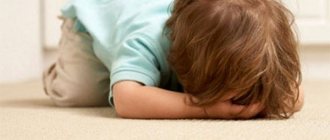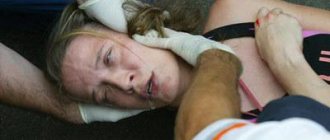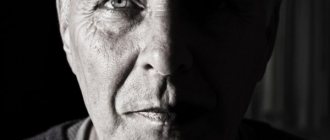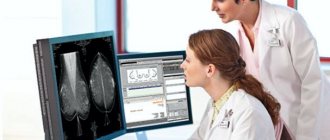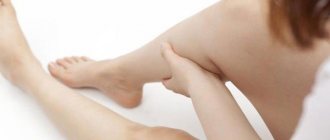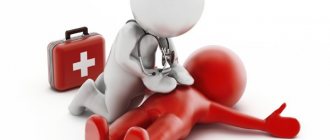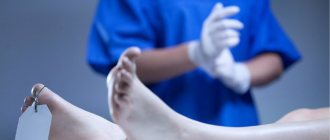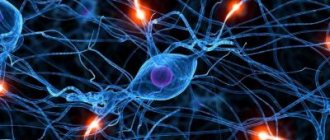Febrile seizures in children are considered fairly common if the child has a fever.
This phenomenon can occur in children under 6 years of age, but most often children aged from six months to 5 years suffer from seizures of this type. By the way, such phenomena are not signs of epilepsy, so parents should not worry about this. However, it is precisely with this symptom that parents most often turn to doctors to examine their child.
Seizures in a child can appear up to 6 years of age. Parents should not panic about this. Febrile seizures are not classified as epilepsy. However, the child needs to be constantly supervised. It is best to carry out special preventive measures so that the child does not have such health problems. When parents encounter this problem for the first time, they do not know what to do about seizures. To prevent this from happening, you must immediately familiarize yourself with the safety measures.
Treatment of febrile seizures in children
During an attack of febrile seizures in children, relief drug therapy is used. It includes tranquilizers from the group of benzodiazepines to relieve convulsions, non-steroidal anti-inflammatory drugs to reduce body temperature. The child is also cooled by physical methods - rubbing with warm or cool water, frequent ventilation of the room, undressing, etc.
For atypical forms of FS, antiepileptic drugs - barbiturates or carboxamide derivatives - can be used. In some cases, if there is a history of febrile seizures in children, preventive treatment may be prescribed using benzodiazepines, valproates, barbiturates and some diuretics with anticonvulsant properties - carbonic anhydrase inhibitors.
Forecast and prevention of febrile seizures in children
The prognosis for life with febrile seizures in children is usually favorable. The outcome can be either complete recovery of the child or transformation into epilepsy. The prognosis is assessed taking into account the likelihood of repeated seizures in the future, transition to epilepsy, the formation of persistent intellectual deficit or impairment of neurological status. Almost always, in children over 5-6 years of age, seizures stop completely. Possible intellectual disorders depend on the frequency and nature of the attacks - in the presence of frequent and atypical febrile seizures in children, there is a higher likelihood of mental development disorders (ZPR, mental retardation). Transformation into epilepsy is observed in 5-15% of patients, more often in the presence of atypical forms of FS.
Nonspecific prevention of febrile seizures in children in the antenatal period includes medical and genetic counseling of married couples, amnio- or cordocentesis followed by genetic analysis in case of a family history. Postnatal preventive measures imply early diagnosis and comprehensive treatment of infectious diseases, metabolic disorders and other precipitating conditions in patients at risk. In order to prevent febrile seizures in children during vaccination at the age of 1-2 years, ADS is used instead of the ADKS vaccine.
The first thing you need to know is that febrile seizures in children have nothing to do with epileptic seizures. Typically, a similar phenomenon is observed in preschool children during severe flu, colds and other diseases accompanied by high fever. Convulsions in children with fever are sporadic and do not recur after the fever subsides.
First aid for a child with seizures
Parents are the first to experience seizures in a child, so they need to know how to help their child in this situation. First you need to call an ambulance.
The help is as follows:
- The child should be placed on a flat surface: a soft carpet, a table covered with a blanket, or grass if the convulsions occurred outside. This way, parents will prevent the baby from getting injured when he starts hitting the surface during cramps. You should not place him on a pillow or soft bed to prevent the baby from suffocating.
- During an attack, the child may choke on saliva or choke on vomit, so he is placed on his side. This makes it easier to breathe and eliminates the possibility of an unpleasant situation.
Before doctors arrive, parents are advised to pay attention to the duration of the convulsive state and its characteristic signs.
During seizures you should remember:
- the position of the child during the attack;
- position of the baby’s limbs and head;
- presence and absence of consciousness;
- condition of the eyes (open or closed).
If the arrival of doctors is delayed for some reason, you must try to lower the temperature yourself.
When febrile seizures occur, the immediate help of parents is the ability to remain calm, because the health of the baby depends on their actions.
When a spasm appears, it is urgent to take action. First aid for febrile seizures in children includes an algorithm of actions that is aimed at preventing injury to the baby during an attack, as well as reducing pain in a small patient.
The emergency aid algorithm is as follows:
- Place the baby on the bed or sofa,
- Move aside all objects that a child could hit.
- Lay the baby on his side, place a pillow under his head,
- If there is difficulty breathing, place a cotton swab with ammonia to your nose,
- You can apply a cold lotion to your forehead, lightly spray your body with cool water, turn on the fan,
- At the end of the attack, let the baby rest - it is recommended to drink an antipyretic.
Today there is no specific treatment for febrile seizures in children. Parents are required to constantly monitor the temperature and correct it with the help of medications.
Should I worry?
Any mother is worried about such conditions in her child. Doctors assure that if convulsive conditions occur only during high fever (from 38 degrees), but do not appear after recovery, there is no reason to worry.
In addition, if the attack lasts less than a quarter of an hour, then it does not require additional treatment. To stop seizures lasting more than 15 minutes, special anticonvulsants are required.
Typically, children from six months to three years old suffer from the disease and tolerate it without consequences.
It’s another matter if febrile convulsions occur in children over 6 years of age. This condition may already indicate epilepsy. And yet, this can only be said after a complete examination.
What causes febrile seizures?
Doctors still don’t know for sure why seizures occur in children at high temperatures. The most common theory is that they, like many other types of seizures, are provoked by inhibitory processes in the development of the brain.
This disease can also be caused by head trauma, drug poisoning, immaturity of the nervous system, congenital defects and genetic diseases.
Only one thing is known for sure - febrile seizures occur against a background of high temperature
. The impetus for this can be not only pneumonia or ARVI, but also regular routine vaccination. In addition, the fever may rise due to an allergic reaction. In this case, there is a risk of confusing febrile convulsions in a child with fever with anaphylactic shock.
In order to truly find out the cause of convulsive conditions, and to stop them in the future, it is necessary to find out whether any of your close relatives have a predisposition to such a syndrome.
How do muscle contractions manifest?
Some mothers often confuse seizures in a child at a high temperature with epilepsy. Indeed, these attacks have some similarities. Signs of a convulsive condition are as follows:
- with tonic convulsions, the child’s body seems to be under current - the legs and arms are stretched out, the head is thrown back, the baby cannot cry, move, or bend the limbs. The body is constantly shaking. As the seizure subsides, large tremors begin to pass through the body, which gradually stops;
- local convulsions are expressed in single twitching of the limbs or individual parts of the body and are more like a nervous tic. Sometimes this state is accompanied by rolling of the eyes;
- against the background of atonic convulsions, symptoms of muscle atrophy appear. Sometimes isolated manifestations of enuresis or involuntary bowel movements may occur.
Complete or partial loss of orientation makes febrile convulsions in a child even more similar to an epileptic seizure. During an attack, the baby may stop breathing for a while.
Sometimes convulsive states last 15 minutes without a break, sometimes in short series. There is a fairly high probability of a similar condition repeating the next time the temperature rises.
Doctor Komarovsky about seizures in a child
Komarovsky associates the resulting febrile convulsions with a sharp rise in temperature. Sensitivity to its high levels is a characteristic feature of the brain of a growing child.
Most children outgrow these seizures without consequences. They cannot be treated if the convulsive state is caused only by high temperature.
The occurrence of seizures is considered a serious phenomenon and parents are required to be attentive to the child’s health. If your baby develops a fever, it should be brought down immediately with antipyretic drugs. It is necessary to ensure that such a child’s readings do not exceed 38 degrees.
Additionally, the baby can take sedatives and calcium supplements prescribed by the pediatrician.
Febrile seizures are a temporary phenomenon that goes away on their own by 5-6 years. During this period, the child’s body matures and periodic physiological changes occur. Komarovsky advises lowering the temperature to prevent seizures. Also, according to the specialist, observation by a local pediatrician is necessary. If the spasms have not gone away after 6 years, a consultation with a neurologist is required.
What should parents do during a seizure?
Many mothers do not know what to do during a child’s seizures at a high temperature, and may panic. Vanity and shouting will not lead to anything good. You need to calm down and act.
- First of all, you need to call a doctor.
- Then undress the child as much as possible, lay him on a hard surface, such as a tabletop, and ensure a flow of fresh air into the room. In summer you can open the window, in winter you can turn on the fan.
- You need to stay close to the child, monitoring his condition. If the baby is holding his breath, there is no need to fiddle with it. It is better to wait until he exhales and begin artificial respiration. During the attack, it is impossible to carry out artificial respiration, since the upper respiratory tract is blocked by the spasm.
- There is no need to take the initiative and try to pour any medicine or water into the child’s mouth. Also, do not unclench his jaws to insert a finger or spoon into his mouth. Such actions can only worsen the baby’s condition.
- To reduce the temperature during an attack, you cannot give medications orally, but it is quite acceptable to use rectal suppositories with paracetamol.
Short-term attacks (up to 15 minutes), occurring sporadically or very rarely, do not require drug treatment.
To stop more frequent and prolonged seizures, the doctor may prescribe anticonvulsants like Phenobarbital, Phenytoin, Valproic acid, etc.
First aid
When a baby experiences convulsions, he should be placed on his side so that he does not choke on his own saliva or vomit, and his legs should be pressed against his stomach. If this is not possible, leave it as is. A roll made from a towel is placed under the head. It is advisable that the bed be hard.
At the same time, you need to call an ambulance and note the time of the onset of the attack. Before the doctors arrive, you need to note all the changes that occur with the baby: frequency, reaction to external irritations, determine the state of consciousness (confused, clear).
The main task of parents, before the doctors arrive, is to ensure that the child does not receive injuries or damage. If foaming is noticed in the mouth, you should use a handkerchief to clear the mouth of mucus and insert a wooden object wrapped in cloth between the teeth. Instead, you can insert a knot tied from the tip of a towel into your mouth. This will protect against the baby biting his tongue during an attack.
Prevention
The manifestations of febrile seizures can only be prevented with medication. This treatment is prescribed by a neurologist in the case of regularly occurring long-term attacks.
One of the indicators for the preventive treatment of febrile seizures in children is the risk of degeneration into epilepsy. Since such a probability is negligible, prophylaxis is prescribed extremely rarely.
Physicians' views on febrile seizures in children have now undergone significant changes as new data and clinical drugs for their treatment have become available.
During ARVI, the body temperature rises in everyone, but not everyone develops convulsions, but only in 18% of children. Once convulsions occur when the temperature rises, this indicates that the child has a more or less severe disease of the central nervous system.
Clinical observation of a child who has seizures
Children who have had seizures during fever should be under constant examination by a pediatrician and pediatric neurologist at their place of residence.
Monitoring the child's condition helps to prevent the occurrence of an attack in the future. The pediatrician will monitor the baby’s development and monitor for possible signs of somatic diseases. A neurologist must competently examine the child and rule out abnormalities in the development of the nervous system.
One of the important tasks of specialists is constant communication with the parents of this child. They clearly explain the specificity of the situation that has arisen, the possible consequences and rules of behavior during an attack.
Features of a febrile attack
Mandatory background conditions in which febrile seizures develop:
- hypoxia of the central nervous system (intrauterine or developed after birth);
- infection of the mother or child with the virus that causes human papilloma;
- birth injury:
- rickets;
- reduced nutrition;
- hypovitaminosis;
- hereditary predisposition;
- rickets;
- delayed psycho-speech development, hyperreactivity, diagnosed after 4 years;
- autonomic disorders, sleep disorders;
- perinatal damage to the central nervous system;
- immunodeficiency;
- impaired microcirculation, difficulty in venous outflow from the brain;
- increased intracranial pressure;
- diathesis or various types of allergies.
Children aged from one month to 7 years, who are prone to frequent colds and viral diseases, are at high risk of occurrence. The most typical age for the onset of febrile seizures is between 12 and 48 months.
The main reason is not elevated temperature, but disruption of the thermoregulation center, the exchange of sleep and wakefulness hormones, and the processes of inhibition and excitation. The body temperature against which a seizure syndrome develops is 37 degrees and above, i.e. there is no direct relationship between the temperature numbers and the likelihood of a seizure.
A child who has had an attack even once due to a rise in temperature should be registered with a pediatric neurologist.
The criteria for diagnosing febrile seizures are the following parameters:
- generalized seizures in all limbs lasting up to 10 minutes;
- normal EEG;
- increased body temperature;
- absence of post-ictal neurological deficit characteristic of epilepsy.
Not typical for febrile seizures:
- Duration more than 10 minutes.
- The child’s age at the time of the first seizures is more than 5 years.
- Body temperature is below 37.3 degrees.
- A focal seizure in a limb or half of the body.
- Pathological changes on the electroencephalogram.
- Recurrence of seizures within 24 hours.
Diseases that need to be excluded in a child when seizures occur for the first time
- epilepsy;
- convulsive syndrome due to neuroinfection (encephalitis, meningitis);
- acute poisoning;
- tumor, consequences of skull and brain trauma;
- hysterical, demonstrative seizures;
- vascular diseases – aneurysms;
- consequences of traumatic brain injury;
- tetanus;
- reaction to vaccinations.
Causes of seizures in infants and newborns
At an early age, the child’s nervous system is underdeveloped and unstable, so convulsions can become a response to various unfavorable factors. Their etymology may vary, but they do not appear without a specific reason. In 75% of cases, doctors determine the cause, but if the attack is isolated and has not been repeated, it is impossible to determine the cause.
The most common of them:
Result of birth trauma
Their cause is hematomas or hemorrhages in the cerebral ventricles that appear after prolonged hypoxia (oxygen starvation) of the fetus in the womb. They are usually clonic or clonic in nature and appear within the first 8 hours after birth.
Hypoglycemic
Appear against a background of low blood sugar. Initially they are expressed in the form of hyperactivity, and then become generalized, tonic. Occurs in the first two days after birth in premature or low-weight infants, against the background of hormonal disorders, asphyxia during childbirth.
Anoxic seizure syndrome
The result of prolonged oxygen starvation of the brain in a child subjected to suffocation, which leads to cerebral edema. The first phase of seizures is tonic and lasts several minutes, and then is replaced by lethargy of the baby. Appears once on the day of birth; when repeated after a month - eon is a signal of the presence of infection in the body or a harbinger of epilepsy.
Convulsions on the fifth day
They appear briefly, between 3-7 days of a child’s life. They are clonic in nature and can be repeated up to 40 times a day. Associated with a lack of zinc in the blood of a newborn.
Seizures of hemolytic disease of the infant
They arise as a result of the toxic effects of bilirubin on the nervous system. They are tonic in nature and may be accompanied by drowsiness, jaundice, and impaired sucking reflex. Kernicterus can affect the subcortex of the brain, which will subsequently cause a delay in the mental or motor development of the baby.
Spasmophilia
Appears due to improper calcium metabolism in the body. It appears on days 3-5 in the form of a spasmodic upward gaze and tonic convulsions of the legs and arms, after which a tonic type of convulsions develops with loss of consciousness.
Pyridoxine dependent
They appear in the first three days of a child’s life due to a lack of vitamin B 6 in the body. They are expressed in the form of muscle twitching, shuddering, and involuntary shaking of the head.
Consequence of brain malformations
Rarely occur in the first 24 hours after birth. As in the first case, a familial syndrome is also rare, in which convulsions are repeated up to 20 times a day already in the second week of life.
Withdrawal syndrome
Seizures are common in babies whose mothers suffer from alcohol or drug addiction and have not stopped taking illicit drugs during pregnancy. The child “comes out” of this state, experiencing the same sensations as the mother.
Types of seizures
- Involuntary paroxysmal muscle tension – tonic.
- Alternation of muscle tone and tension, occurring involuntarily - clonic.
- Mixed - tonic and clonic.
- Generalized muscle spasms of the body.
- Cramps in an isolated muscle group.
Febrile convulsions in children are accompanied by a reaction of the whole organism in the form of impaired breathing, heart rate, and loss of consciousness. Due to breathing problems, hypoxia develops, the face becomes cyanotic, and becomes covered in large drops of cold sweat.
What is not recommended for a child to do during seizures?
If an attack occurs, parents are prohibited from doing the following:
- The child should not be pressed against the surface, because the convulsions cannot be stopped, and the baby may get injured (fracture).
- It is forbidden to put various objects into the child's mouth, as this can lead to damage to the teeth and jaw.
- During an attack, the baby does not need to be given water or medicine; he may choke. Antipyretic drugs should be given 15 minutes after the attack, after making sure that the child has regained consciousness.
- The baby does not need artificial respiration; this should only be done in case of cardiac arrest.
- Parents should not leave their child alone while he or she is having a seizure. This may threaten the baby's life.
Febrile seizures in a child last about several minutes and go away on their own. Therefore, parents simply need to protect their baby from the dangers that appear during attacks.
Diseases that mask seizures in children
- Facial muscle spasms are very easy to diagnose: a spasm appears in one half of the face, the eye closes, and the neck muscles tense. A grimace of pain appears on the face. The cause may be tumors, vascular diseases, neurosis, neuritis of the facial nerve.
- Forced hyperkinesis - forced movement of the head and limbs - chorea, cerebral palsy.
- Spasmodic torticollis - spasms in the muscles of half the neck. Characteristic of congenital anomalies.
- Blepharospasm is rapid, forced blinking. Occurs in malignant tumors, poisoning, after unsuccessful dental treatment with nerve injury, demyelinating and degenerative diseases of the nervous system.
- Nervous tics of the eyelids develop after stress or trauma to the nervous system.
- Epileptic seizures in childhood are characteristic of space-occupying brain lesions (tumors, abscesses, encephalitis), consequences of trauma, infection, and independent disease - epilepsy.
- An infection accompanied by elevated temperature has the ability to mask febrile convulsions and manifest itself with severe neurological symptoms in the later stages.
What should parents pay attention to?
Febrile seizures in children after 4 years of age in 86% transform into regular causeless epileptic seizures.
If one of your relatives has had febrile seizures, then the probability that the child will develop similar reactions to elevated body temperature is 1.
There is a 100% correlation between febrile seizures and sleep disorders. Therefore, if a child has any of the sleep disorders, it is advisable to contact a pediatrician or neurologist. Particular attention should be paid to an increase in body temperature in a child with pathology of sleep and wakefulness.
If, against the background of an increase in body temperature, the child has at least once had a convulsive reaction, then it is necessary to carefully prepare for preventive scheduled vaccination with any vaccinations.
Seizures can develop after any vaccine. More often they appear after vaccination against whooping cough, measles, and DPT administration.
The most dangerous period lasts 2 days from DTP vaccination, 10 days from measles.
When a non-live vaccine is administered, they develop on the first day after vaccination, and when a live vaccine is used, on days 7–10.
If a child develops seizures a week after vaccination, then these are afebrile seizures.
Afebrile convulsive syndrome, i.e. without fever, indicates diseases of the nervous system in the child that were not diagnosed in time. And the vaccine simply became a provoking factor.
When a child turns 4 years old, this is not a reason for parents to relax. From 4 to 12 years of age it can occur acutely, suddenly after ARVI, influenza, chickenpox, measles, while taking medications containing salicylic acid - aspirin. In addition to seizures, there are:
- breathing problems;
- drowsiness;
- loss of consciousness;
- increased levels of liver enzymes AST, ALT, indicating liver damage. However, the bilirubin level remains normal.
The condition develops acutely and ends in death in 20% of cases. There is no specific treatment. Only timely diagnosis and therapy aimed at maintaining vital functions, breathing and circulation can save a child’s life.
If the child managed to survive the acute phase of the disease, then consequences remain in the form of mental retardation and epileptic seizures. Prevention of the disease is aimed at limiting the use of acetylsalicylic acid when the body temperature rises in a child under 12 years of age.
Treatment methods
The main attention should be aimed at preventing a significant increase in body temperature. If a convulsive syndrome has developed, then Relanium is immediately administered intramuscularly at an age-appropriate dosage of 0.5 mg/kg of the child’s body weight.
If a child had convulsions against the background of an increase in body temperature, convulsive activity was detected on electroencephalograms, changes in magnetic resonance imaging, then constant use of anticonvulsants is indicated.
The choice of drugs to reduce body temperature in children
- The drug of choice is paracetamol (acetaminophen, Tylenol, Panadol, Calpol) at a dosage of 12 mg/kg at a time and up to 90 mg/kg per day. This is a drug with a central effect, which has an analgesic effect and does not cause side effects from the stomach.
- Ibuprofen, unlike paracetamol, has a negative effect on the stomach and kidneys. May cause heartburn and abdominal pain.
- Rubbing with water at room temperature.
Antipyretics that are best not given to children:
- acetylsalicylic acid - aspirin;
- analgin causes allergic reactions up to anaphylactic shock, inhibits hematopoiesis, reduces blood pressure and body temperature to 34 degrees.
The consequences of taking aspirin and analgin in children are so serious that in most countries of the world they are prohibited for use in children under 15 years of age. All drugs containing these substances are specially labeled to prevent their use in children.
During the first year, with the next increase in body temperature over 39 degrees, which does not decrease after taking antipyretics, Relanium, diazepam, nitrozepam in tablets, microenemas or suppositories are prescribed.
Prevention
If there is a tendency to febrile convulsions, changes in the EEG, MRI, or if relatives have similar episodes in the past, anticonvulsants are constantly prescribed for up to 2 years.
In other cases, prophylactic anticonvulsant therapy is not prescribed due to the high risk of side effects and complications.
The drugs of choice are valproic acid derivatives (Depakine, Convulex, Convulsofin) or phenobarbital. In 10% of children, febrile seizures develop into epilepsy.
We can talk about febrile seizures in the event of convulsive (convulsive) seizures at high body temperature (above 38 C) in children under six years of age who have not previously suffered from convulsive seizures.
Treatment depends, first of all, on the duration of the seizures: if they last less than fifteen minutes, it is enough to reduce the temperature with antipyretics and then monitor the child’s condition. If seizures last more than 15 minutes, then it is necessary to provide treatment with anticonvulsants.
It is necessary to distinguish a disease such as epilepsy from febrile seizures. If seizures occur in children over 6 years of age, then the child most likely suffers from epilepsy.
Febrile seizures affect 5% of all children under six years of age. Most often, febrile seizures are observed in children from six months to three years.
Causes of febrile seizures
The causes of febrile seizures in a child have not yet been fully established. But it is known for certain that one of the main factors is the weakness of inhibitory processes and insufficient maturity of the nervous system, which creates conditions for the occurrence of seizures.
Febrile seizures occur only against a background of elevated temperature.
The appearance of febrile convulsions can be triggered by a common cold, ARVI, teething, as well as various vaccinations.
One of the most important factors in the development of febrile seizures is considered to be a hereditary predisposition, for example, if his parents or other relatives have epilepsy.
Signs and symptoms of febrile seizures
As mentioned earlier, febrile seizures are not regarded in medical practice as a form of epilepsy, although they have a number of external signs common to this disease.
Febrile seizures are divided into:
- tonic convulsions
- significant tension in a child of all the muscles of the body (rolling the eyes and throwing the head back, bending the arms to the chest, straightening the legs), followed by rhythmic shudders or twitches, gradually becoming more rare and gradually disappearing; - atonic convulsions
- instant relaxation of all muscles of the body, involuntary loss of feces and urine; - local convulsions
- twitching of limbs, rolling of eyes.
Most often, during seizures, the child does not respond to the actions and words of his parents, loses contact with the outside world, stops crying, may turn blue and hold his breath.
Rarely do seizures last more than 15 minutes. In some cases they can occur in series.
One in three children who have previously experienced febrile seizures experience them during subsequent episodes of fever.
Diagnostics
A child suffering from seizures should be shown to a pediatric neurologist. The doctor will rule out neurological causes of seizures, in particular various forms of epilepsy.
The complex of examinations for children with febrile seizures includes:
- cerebrospinal fluid analysis and lumbar puncture to rule out encephalitis or meningitis;
- biochemical and general analysis of urine and blood;
- computed tomography or nuclear magnetic resonance;
- electroencephalogram (EEG).
Treatment of febrile seizures
If your baby develops febrile seizures, you should immediately call an ambulance. Before the ambulance arrives, it is necessary to provide the child with first aid:
- Call for help if you and your child are alone;
Immediately place a child with convulsions on a hard, flat surface and turn his head to the side;
It is important to monitor your baby's breathing rhythm. If he is not breathing and is tense, you need to wait until the convulsions end and begin artificial respiration. During the attack itself, artificial respiration is useless;
There is no need to try to open the child’s mouth and stick a finger, spoon or other objects into it - this can only aggravate the situation;
Ventilate the room and undress the child. Indoor air temperature should not exceed +20 degrees C ̊.
Use physical methods to reduce high fever (for example, rubbing with water and vinegar);
Give your child an antipyretic (preferably paracetamol suppositories);
You should not leave the baby alone until the febrile convulsions stop or try to give the baby a drink of water or force him to swallow medicine.
Many people have never encountered the concept of “febrile seizures.” However, the phenomenon is by no means rare and occupies a serious niche in pediatric practice.
Remember, it is not the seizures themselves that are threatening for a young patient, but the etiological factors of febrile seizures. It is important to diagnose the disease in the early stages; seizures are a kind of signal from the child’s body, possibly indicating the development of a serious pathology. Common causes of febrile seizures are epilepsy and neurological deficits. In Russia, Dr. Komarovsky is studying the treatment and diagnosis of the disease. The disorder is being seriously studied at the WHO level; in the ICD-10 classification of pathology, its own code is assigned R56.0 Convulsions during fever.
According to statistics, febrile seizures are a common neurological disease that manifests itself in childhood. The word “febrile” in medicine indicates increased body temperature. A febrile temperature is usually understood as an increase to 38-38.5 degrees. However, the mechanisms of thermogenesis during febrile convulsions are not fully understood; it is difficult to explain the reason for the increase in body temperature during convulsions.
Febrile convulsions are spasms of the muscle tissue of the body, which can occur in a clonic or tonic manner. It occurs exclusively in children of preschool and school age in the form of seizures with an obligatory increase in body temperature to 38.5 C. Convulsions develop mainly in the extremities. Convulsions of this type are dangerous, often transforming into afebrile convulsions (occurring without an increase in temperature), becoming a sign of deterioration of the condition, or into epilepsy. If convulsions occur without fever, the diagnosis of “febrile convulsions” is not considered correct. In adults, the likelihood of developing such seizures is minimal.
When making a diagnosis, it is important to take into account age parameters. “Febrile seizures” develop exclusively in the age range from 6 months to 6 years. According to foreign pediatricians, 3-5% of children aged six months to five years had a one-time solitary episode. More than 90% of patients diagnosed with febrile seizures are children from 6 months to 3 years. The older the child, the lower the risk of developing pathology. According to WHO statistics, the worldwide prevalence of the disease is up to 5%.
Symptoms of the disease
Febrile convulsions occur in acute diseases and infections of the respiratory tract, gastroenteritis (inflammation of the stomach and small intestine), otitis (inflammation of the ear), which occur with fever.
There are several types of spasms - local, tonic, atonic:
- with the local type, twitching of the limbs and rolling of the eyes are observed;
- with the atonic type, all muscles relax, which is accompanied by involuntary urination and stool eruption;
- with the tonic type, first the whole body tenses, the head is thrown back, the pupils roll back, the lower limbs are straightened, and the upper limbs are pressed to the chest. Then intense twitching appears, gradually decreasing in rhythm.
During this period the skin turns blue , breathing weakens, and crying stops. Until the spasms stop, it is useless to appeal to consciousness - the child completely loses contact with the outside world.
The seizure lasts no longer than 20 minutes, after which sleep most often occurs. It is important for parents to be on guard, because usually during the day, spasms can recur several times.
Etiology
Children at a young age are active, the immune system is imperfect, children are often susceptible to infectious diseases - provoking factors for the development of febrile seizures. More than a third of the registered cases of diagnosing febrile seizures in children under one year of age occurred against the background of an infectious disease. Diseases caused by the herpes virus type 6 pose a serious danger. Bacterial infection is of great importance in the development of the disease. Contamination of the respiratory tract with bacterial agents and acute gastroenteritis directly lead to febrile convulsions. As Dr. Komarovsky notes, non-infectious causes of the disease are known:
- Teething.
- Hyperthermia of various origins: increased temperature against the background of endocrine pathology, psychogenic, resorptive, reflex, central origins.
- Violation of the content and metabolism of individual micro- and macroelements.
- Genetic predisposition. Symptoms of febrile seizures are observed in 25% of children whose parents suffered from the disease in childhood. 20% of registered patients have no family history of febrile seizures. The mechanism and type of inheritance of pathology from parents is not fully understood, and it is not easy to protect against the manifestation of the disease. Genetics suggest the presence of an autosomal dominant type or polygenic transmission, which makes it difficult to interrupt the transmission of the trait in the family.
Complications of seizures
Various factors can provoke a convulsive state, leading to hyperthermia in a child. Seizures occur against the background of:
- febrile temperature (38.1-39);
- high febrile, if the child has a temperature of 39 or higher (39.1-41);
- hyperpyretic fever (over 41).
The causes of seizures can be described as:
- infectious;
- non-infectious.
Several diseases fall into this category:
- respiratory;
- intestinal;
- neurogenic.
Diseases are caused by bacteria, viruses, chlamydia, protozoan parasites, pathogenic fungi, and mycoplasma. In children under one year of age, convulsions appear due to the herpes virus entering the child’s body.
Febrile seizures in a child can be caused by non-infectious signs, such as:
- overheat;
- teething;
- dehydration;
- abnormalities of the nervous system (tumors, head injuries);
- neuroses, psychoses;
- metabolic disorders, allergic reactions;
- state of shock;
- post-vaccination reaction;
- hereditary factors;
- allergies to medications.
The convulsive condition, which occurs mainly in children under 6 years of age, is associated with the formation of the brain. This occurs for a certain period after the birth of the child. The processes of excitation in the nervous tissue dominate over the processes of inhibition, usually until the child is 6 years old.
Only the attending physician can give an accurate prognosis for a particular child, because the consequences can be very different. The severity of complications depends entirely on the type of seizures, their duration and frequency.
When making a prognosis for a child suffering from convulsive conditions, the following factors must be taken into account:
- the likelihood of recurrence of seizures;
- the possibility of converting them into epilepsy;
- the risk of neurological, including intellectual, developmental disorders.
Why are febrile seizures dangerous? In most cases, convulsive conditions pass without consequences and do not have any impact on the child’s future life.
Complex forms of seizures can develop into epilepsy, but this occurs in 5–15% of all cases. The danger lies in the development of developmental delays in the child. This occurs with atypical seizures.
The occurrence of a convulsive state in newborns and children under 6 months is very dangerous. After all, a child at this age is still very weak. Parents who suffered from such symptoms in childhood should constantly show their baby to the pediatrician and try to protect him from contact with infections.
Febrile seizures in most cases are a phenomenon that does not entail any consequences and does not require special treatment. However, parents should consult a doctor so as not to miss possible complications and dangerous diseases.
Febrile convulsions in a child at a high temperature are very dangerous, so you should not allow it to rise above 37.5º. If parents ignore such requirements, the following complications may develop:
- Epilepsy,
- Increased tendency to muscle spasms,
- Damage to blood vessels and nerves during an attack,
- Acquired injuries during a seizure.
The most serious consequence of febrile seizures in children is epilepsy. If you do not allow the development of fever, this pathology can be avoided - after 6 years of age, the disease disappears.
Clinical picture of the disease
As a rule, an attack of febrile seizures develops as a generalized epileptic seizure. The word “generalized” refers to symmetrical damage to the limbs. Recently, doctors have noted the absence of signs of strict symmetry. The ambiguous symptoms of the disease have led to the division of forms of the disease into two large groups: typical and atypical forms of the disease.
Typical attacks of such convulsive spasms last on average 15 minutes, are widespread, and damage to the limbs is symmetrical. The child's psychomotor development corresponds to age standards.
In atypical forms, an attack can last up to several hours. The nature of the attack is widespread; local damage to a specific area cannot be ruled out. With atypical forms of the disease, the child’s history often shows indications of central nervous system lesions and traumatic brain injuries.
Sometimes there is an additional classification of febrile seizures - simple and complex. Not to be confused with typical and atypical forms. In complex forms, the child’s attack lasts more than 30 minutes, and relapses are observed within 24 hours.
Diagnostics
It is necessary to diagnose the disease as early as possible. This is the key to a speedy recovery. Making a diagnosis of febrile seizures in a child is a difficult task. To be sure of the diagnosis you need:
- conduct a thorough family history examination;
- correctly assess the somatic, neurological, psychomotor symptoms, and emotional status of the patient;
- take into account the characteristics, nature, duration and localization of attacks;
- assess the presence of post-attack symptoms and complications.
Popular methods of instrumental and laboratory diagnostics are imperfect and are not able to fully provide the foundation for making a diagnosis. CT and MRI rarely detect changes. The only reliable source of information is an EEG, a study a few days after the attack. Even the EEG shows no changes in 30% of cases. Lumbar puncture is used, although the procedure is performed primarily to exclude the diagnosis of neuroinfection.
A little about diagnostics
When a child has a febrile seizure, the effects can manifest themselves in different ways. Therefore, after an attack, the baby must be shown to a neurologist. Diagnosis consists of excluding certain factors of seizures, in particular epilepsy.
Initially, the doctor examines the child, checking his reflexes and interviewing the parents. He is interested in whether there were people in the family with similar problems, how many minutes the attack lasted and what position the child was in.
The doctor checks the baby’s development according to age: how he walks, talks, and whether he can hold objects normally.
The child's examination includes:
- General and biochemical analysis of blood and urine.
- Computed tomography.
- Electroencephalogram.
- Ultrasound of the brain.
- In rare cases, a spinal tap may be prescribed.
Based on the examination, the doctor prescribes treatment. In many cases, febrile seizures in a child do not affect his health in any way. However, only a specialist can confirm or refute the possible negative consequences of a convulsive state.
The main way to identify febrile spasms is an examination by the attending physician and complaints from parents. Accurate diagnosis allows you to identify the chronic disease that caused the fever. Obvious neurological disorders can be confirmed by CT (computed tomography) or MRI (magnetic resonance imaging), as well as laboratory blood tests. Children with seizures are under constant supervision of a pediatrician. If necessary, a consultation with a neurologist and other related specialists is carried out.
Treatment of febrile seizures
Help for febrile seizures is provided directly during an attack and in the period between seizures. During an attack, medications are used:
- diazepam or seduxen with a dosage of 0.2-0.5 mg/kg per day;
- lorazepam – 0.005-0.2 mg/kg/day;
- phenobarbital – from 3 to 5 mg/kg.
Average dosages are given. The exact doses are prescribed by the attending physician, taking into account the patient’s age and the severity of the disease. To reduce the temperature during an attack, it is advisable to use physical cooling methods. Medications are used - ibuprofen, paracetamol. It is important to immediately begin lowering the temperature, even if the numbers do not reach febrile levels.
Treatment during the interictal period
Despite the controversy among doctors about the need for treatment during the interictal period, treatment is carried out. In the first two days after an attack, children often experience symptoms of fever; symptoms must be relieved with the drug diazepam at a dosage of 0.4 mg per kilogram of body weight every 8-10 hours. Then treatment of febrile seizures is performed according to one of three scenarios:
- Long-term use of antiepileptic drugs.
- Taking intermittent drugs, possibly in combination with antiepileptic drugs.
- A complete refusal of drug treatment is possible, with the exception of antipyretics.
For a specific case of disease, a separate treatment regimen is selected. Among antiepileptic drugs, doctors prefer Carbamazepine and Phenobarbital. Gradually, more and more doctors are abandoning drug therapy for febrile seizures.

